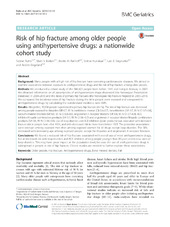| dc.description.abstract | Background: Many people with a high risk of hip fracture have coexisting cardiovascular diseases. We aimed to examine associations between exposure to antihypertensive drugs and the risk of hip fracture among older people. Methods: We conducted a cohort study of the 906,422 people born before 1945 and living in Norway in 2005. We obtained information on all prescriptions of antihypertensive drugs dispensed (the Norwegian Prescription Database) in 2004–2010 and the dates of primary hip fractures (the Norwegian Hip Fracture Registry) in 2005–2010. We compared the incidence rates of hip fracture during the time people were exposed and unexposed to antihypertensive drugs by calculating the standardized incidence ratio (SIR). Results: Altogether, 39,938 people experienced a primary hip fracture (4.4 %). The risk of hip fracture was decreased among people exposed to thiazides (SIR 0.7, 95 % confidence interval (CI) 0.6–0.7), beta-blockers (SIR 0.7, 95 % CI 0.7–0.8), calcium channel blockers (SIR 0.8, 95 % CI 0.8–0.8), angiotensin II receptor blockers (SIR 0.8, 95 % CI 0.7–0.8), ACE inhibitor/thiazide combination products (SIR 0.7, 95 % CI 0.6–0.7) and angiotensin II receptor blocker/thiazide combination products (SIR 0.6, 95 % CI 0.6–0.6). Use of loop diuretics and ACE inhibitors (plain products) was associated with increased fracture risk in people born after 1924, and with decreased risk in those born before 1925. The protective associations were stronger among exposed men than among exposed women for all drugs except loop diuretics. The SIRs decreased with increasing age among exposed people, except for thiazides and angiotensin II receptor blockers. Conclusions: We found a reduced risk of hip fracture associated with overall use of most antihypertensive drugs, but an increased risk with loop diuretics and ACE inhibitors among people younger than 80 years and in new users of loop diuretics. This may have great impact at the population level, because the use of antihypertensive drugs is widespread in people at risk of hip fracture. Clinical studies are needed to further explore these associations. | en_US |

